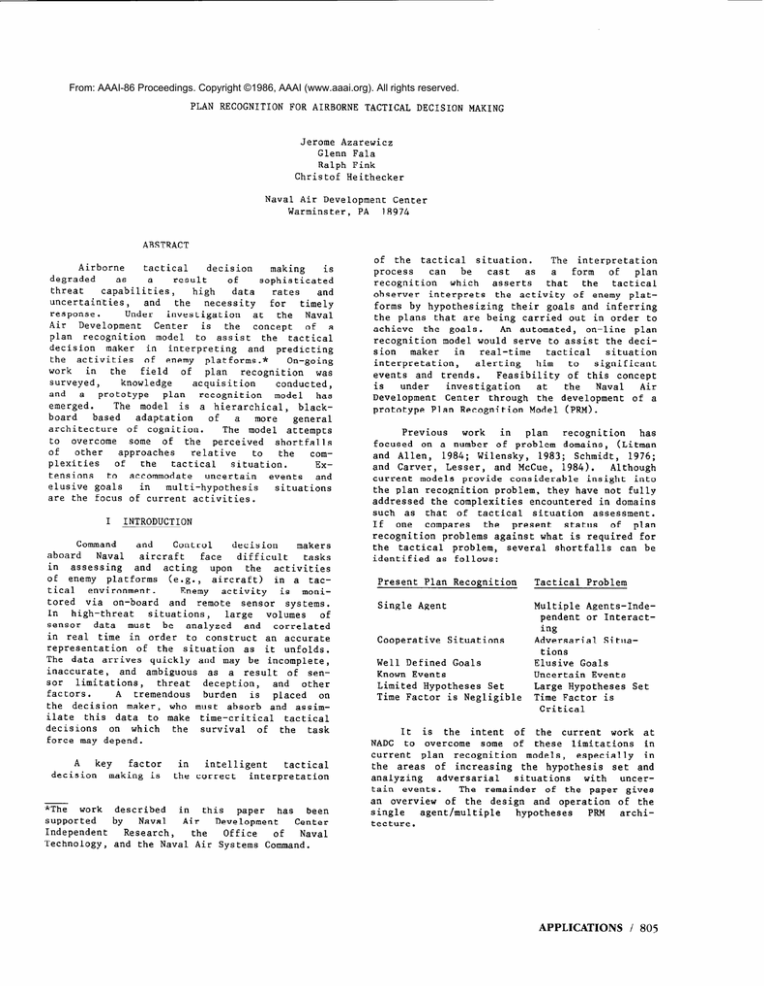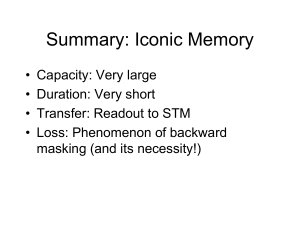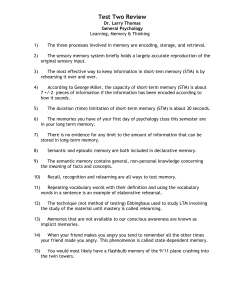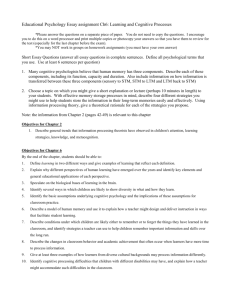
From: AAAI-86 Proceedings. Copyright ©1986, AAAI (www.aaai.org). All rights reserved.
PLAN
RECOGNITION
FOR AIRBORNE
TACTICAL
DECISION
MAKING
Jerome Azarewicz
Glenn Fala
Ralph Fink
Christof Heithecker
Naval Air Development
Center
Warminster,
PA
18974
ABSTRACT
Airborne
tactical
decision
making
is
degraded
as
a
result
of
sophisticated
threat
capabilities,
data
rates
high
and
uncertainties,
and
the
necessity
for
timely
response.
Under
investigation
at
the Naval
Air
Development
Center
is
the
concept
of
a
plan
recognition
model
to assist
the tactical
decision
maker
in interpreting
and
predicting
the activities
of enemy
platforms.*
On-going
work
in
the
field
of
plan
recognition
was
surveyed,
knowledge
acquisition
conducted,
and
a
prototype
plan
recognition
model
has
emerged.
The model
is a hierarchical,
blackboard
based
adaptation
of
a
more
general
architecture
of cognition.
The model attempts
to overcome
some of the perceived
shortfalls
of
other
approaches
relative
to
the
complexities
of
the
tactical
situation.
Extensions
to accommodate
uncertain
events
and
elusive goals
in
multi-hypothesis
situations
are the focus of current activities.
I
INTRODUCTION
Command
and
Control
decision
makers
aboard
Naval
aircraft
difficult
face
tasks
in assessing
and
acting
activities
upon
the
of enemy platforms
in a tac(e.g., aircraft)
tical
environment.
Enemy
activity
is monitored via on-board
and remote
sensor
systems.
In
high-threat
situations,
large
volumes
of
sensor
data
must
be
analyzed
and
correlated
in real time in order to construct
an accurate
representation
of the situation
as it unfolds.
The data arrives quickly and may be incomplete,
inaccurate,
and ambiguous
as a result of sensor
limitations,
deception,
and
threat
other
factors.
A
tremendous
burden
is placed
on
the decision
maker, who must absorb and assimilate this data to make time-critical
tactical
decisions
on which
the
survival
of the task
force may depend.
A
factor
key
decision
making is
*The
work
supported
Independent
Technology,
in
intelligent
tactical
the correct
interpretation
described
in
this
paper
has
been
by
Air
Naval
Development
Center
Research,
Office
of
the
Naval
and the Naval Air Systems Command.
The interpretation
of the tactical
situation.
form
of
plan
can
be
cast
as
a
process
tactical
which
asserts
that
the
recognition
observer
interprets
the activity
of enemy platforms by hypothesizing
their goals and inferring
the plans that are being carried out in order to
An automated,
on-line plan
achieve
the goals.
recognition
model would serve to assist the decitactical
situation
sion
maker
in
real-time
alerting
him
to
significant
interpretation,
events and trends.
Feasibility
of this concept
Air
under
investigation
at
is
the
Naval
Development
Center
through the development
of a
prototype Plan Recognition
Model (PRM).
Previous
work
in
plan
recognition
has
focused on a number of problem domains,
(Litman
1984; Wilensky,
1983; Schmidt,
1976;
and Allen,
Although
and McCue,
1984).
and Carver, Lesser,
current models provide considerable
insight into
the plan recognition
problem, they have not fully
addressed the complexities
encountered
in domains
such as that of tactical
situation
assessment.
of plan
If
one
compares
the
present
status
recognition
problems against what is required for
several shortfalls
can be
the tactical
problem,
identified as follows:
Present
Single
Plan
Recognition
Agent
Cooperative
Situations
Well Defined Goals
Known Events
Limited Hypotheses
Set
Time Factor is Negligible
Tactical
Problem
Multiple Agents-Independent or Interacting
Adversarial
Situations
Elusive Goals
Uncertain Events
Large Hypotheses
Set
Time Factor is
Critical
It is the intent
of the current
work at
NADC
to overcome
some of these limitations
in
especially
in
current
plan recognition
models,
the areas of increasing
the hypothesis
set and
unceradversarial
situations
with
analyzing
tain events.
The remainder
of the paper gives
an overview
of the design and operation
of the
hypotheses
PRM
archisingle
agent/multiple
tecture.
APPLICATIONS
/ 805
II
PRM:
COGNITIVE
ARCHITECTURE
OVERVIEW
The design
of the PRM was largely derived
from the work done by Anderson on the Architecture
Figure
1 is an
of Cognition
(Anderson,
1983).
of three major
of our interpretation
overview
Long Term Memory,
of this theory:
components
Procedural Memory, and Short Term Memory.
Procedural
Long Term Memory
Memory
Knowledge about how goals
and plans are Inferred,
mamtamed. and revised
Declarative
descriptions
of
goals, plans, platform
tactics and mlsslons
Short Term Memory
sensor
data/
external
4
information
Storage and control of the
current state of the world
Contains the set of active
hypothesized plans
most
-goal
likely
and plan
both
short
term memory
and long term memory,
procedural
memory
is the vehicle
for matching
to plan strucobservations
of the environment
weighing
hypotheses
tures,
postulating
goals,
Components
of
PM
revising
plans.
and
utilities
strategies
and
for
include
search
matching objects stored in LTM.
Short term memory (STM) is the storage
results
of
the
the
intermediate
space
for
about
recognition
Knowledge
process.
plan
of the world
resides
here,
the current
state
of the environment,
the
such
as measurements
history
of observed
events,
the set of active
hypothesized
plans,
and the measures
of belief
disbelief
associated
with
these
plans.
and
procedural
STM
is
which
the
medium
through
LTM;
procedural
memory
memory
interacts
with
in LTM
stored
will
only
act
on
those
plans
which have been retrieved and posted on STM.
III
FIGURE
1.
PLAN
RECOGNITION
MODEL
ARCHITECTURE
Long
term memory
(LTM) consists
of a dedescription
of the set of missions
clarative
which
can be held by an agent under
observaEach mission
is represented
by a class
tion.
of plans which
can be performed
to achieve
a
The structure
of these plan
particular
goal.
can be
Plans
descriptions
is hierarchical.
decomposed
into
a sequence
of events,
which,
set
of
into
a
in
turn,
can
be
decomposed
the
Constraints,
(Figure
2).
parameters
necessary
conditions
for the occurrence
of an
at each level
object
in the LTM, are imposed
the
plan
parameters)
of
event,
or
(plan,
If a constraint
has been violated,
hierarchy.
to which
the constraint
the LTM
object
then
is attached cannot have occurred.
conlexlual
JPlanl
pla”ofm
PLAN LEVEL
PARAMETER
I
Figure
2.
Plan
I
I
expected and allowable ranges
dagree 01 match computaban
Structure
Organization
Procedural Memory (PM) contains knowledge about how to reason about the state of
the world.
Using the knowledge resident in
806
/ ENGINEERING
PRM COMPONENT
DESCRIPTIONS
In the following
sections,
the PRM is discussed in the domain-specific
context of airborne
Knowledge
acquisition
tactical decision making.
activities were carried out to extract and represent the declarative
and procedural knowledge
the
decision maker brings to bear in the plan recognition process.
Work has focused on achieving a
PRM that can generate and maintain multiple hypotheses to interpret and predict the behavior of a
Extensions
to accomsingle
threat
platform.
under
modate
multiple
platforms
are currently
study but will not be discussed below.
A.
Long
Term Memory
LTM consists of a declarative
description
of
a set of possible
missions
held by an observed
platform.
Each mission
represents
a class of
plans whose
successful
execution
results in the
For example,
achievement
of the mission
goal.
class ATTACK
can be
the goal
of the mission
achieved
by invoking
one of several
available
plans or variations
of plans in the ATTACK class.
Several
different
platforms
may have the same
plans to achieve
mission goal but use different
On the other
hand,
platform
limitations
it.
restrict the set of plans that may be executed to
achieve a particular
mission.
The plan description must capture the significant
features of the
be
achieved.
The
ways
a mission
goal
may
following
is a discussion
of the two components
structure
in LTM:
the
plan
of
each
plan
hierarchy
and the Deterministic
Finite Automata
(DFA).
The hierarchical
component defines a plan as
tiered structure
(Figure 2) consisting
of a plan
parameters
pername, a set of events, various
and constraints
at each
taining
to the events,
tier in the hierarchy.
Constraints
in the plan hierarchy
form a
nested set of necessary
conditions which must be
The matching of
satisfied for entry to a tier.
environment
measurements
against
objects
in the
the constraints
plan structure
involves checking
event,
and
within
the structure
of the plan,
the
If a measurement
of
parameter
levels.
the
environment
satisfies
the plan constraints,
plan is plausible
and the event constraints
may
if these are satisfied
for a parbe checked;
parameter
that
event's
ticular
event,
then
The constraints
may
be checked.
constraints
the search spaces of both the
serve to reduce
plans possibly held by the platform and the event
being performed within that plan.
The events are temporarily
ordered features
which a tactical decision maker judges to be significant
for hypothesizing
of inferring
a plan
held by a platform.
The events, in turn, consist
of a set of observable
parameters and their assodefine
Parameters
that
ciated
constraints.
measures
of the platform's
an event
represent
and
emissions
kinematics
(platform
motion)
signals)
behavior
that
are
(electromagnetic
Each
expected and allowable
within that event.
parameter
that
characterizes
an event
has
an
of values.
To allow
expected value or interval
the
for variations
in the unfolding
of events,
constraints
extend
the expected
parameter
value
for
out to the maximum
allowable
range
range
If the event constraints
the particular
event.
then
are satisfied
by an observed
measurement,
it is possible
that the platform
is executing
Otherwise,
this event in the hypothesized
plan.
this event cannot be held by the platform.
Event
boundaries
in
the
plan
structures
are
defined
in
terms
of
significant
transivalues.
The
tions
in
expected
parameter
1 (El, E2, etc.)
are delinevents
in Table
eated with respect
to a set of expected
paraWhen
meter
values
over
an
expected
range.
there is a significant
change
in the expected
parameter
values,
a transition
from one event
For instance,
the drato the next
occurs.
in the altitude
of the bomber
in
matic change
Table 1 indicates a transition
from El to E2.
TABLE
1.
PARTIAL DECLARATIVE
DESCRIPTION
BOMBER ATTACK PLAN
El
E2
:
through
constraints
provides
for
the
values
gradual
transition
from
one
event
to
the
next.
Knowledge
about to which event the plattransition
is embodied
form
will
within
the
This
concept
is discussed
at the end
DPA.
of this section.
TABLE
SAMPLE
2.
I
I
I
R4
R5
EVENT CONSTRAINTS
ATTACK PLAN
I
I
1
5
i
I
1
j
1
1
1
R2
1
FOR
BOMBER
I
1
l
1
RO
Rl
Range, nm
A measure of belief for the platform's events
and state can be obtained by comparing the actual
platform measurements
against the expected/allowRules
attached
to the
able parameter
values.
parameter values in the plan structure are invoked
to determine
the degree of membership
and assoAttached
to each
ciated belief
in the event.
kinematic parameter are linear functions which are
used to determine
the degree-of-match
(DOM) between an observed value for a parameter
and the
values
parameter
expected/allowable
for
that
(Table 3). Utilizing kinematic information of the
measurement,
the linear functions return a value
which falls into one of three classes:
exact,
partial,
and none.
The three results
can be
interpreted as follows:
Exact:
The measurement
falls within the expected
range of values--the
measurement
is a member of
the event-parameter
set.
Partial:
The measurement
falls within the allowable
range
of
values--the
measurement
is a
plausible member of the event-parameter
set.
None:
The measurement
falls outside of the allowable range of values --the event is removed from
consideration.
EVENT
Imm
TABLE
3.
SAMPLE KINEMATIC
PARAMETERS
OF BOMBER ATTACK PLAN
g
FP
Corn
Rad
FOR EVENT
1
Interpretation of Hatcher Results
ECH
Exact
CPA
W-L
*s
.
*4
Alt
.
*3
Range, nm
*2
*I
range
b.I,
b rn
= '
*0
The event constraints
serve to extend
the
event
boundaries
out
to the maximum
expected
each
event
parameter
values
for
allowable
extended
event
Because
of these
(Table
2).
events
overlap
in
parameter
boundaries,
may
time.
The relaxation of expected parameter
range
Vel
b *.I
range
350-450
= '
0 5 - I
None
Partial
range 40-50K
25-40K
i
,&jyj
range
ait - s/3
range. O-350
b
",I = &
vel
-------_-_---_______-----range 450-750
b vr, = - &vel
+ 2 8
b a,,
O-25K.
= 0 +
range
b "II
,50K
remove
event
remove
event
remove
event
> 700
= 0 +
range
0 - 5
range
b -=
21mm
bmm’
-10-o
Imm
hmm= I
APPLICATIONS
/ 807
Knowledge
about
emission
parameters
represents
the decision
maker's
heuristics
used
to
support
or refute
a plan hypothesis
(Table 4).
This differs
from the more computationally
inkinematic
tensive
match.
A series
of actions
when an emission
measurement
satare initiated
isfies
certain
preconditions;
a message
e.g.,
may be issued
to increase
or decrease
the belief in the plan,
or even
remove
a plan from
consideration.
For example
if a bomber ID signal
is observed,
a message
will
be posted
to
remove all plans that cannot be held by a bomber.
Values for the emissions
parameters
represent
strong
evidence
to support
or
refute
a
hypothesized
plan.
TABLE
4.
EMISSIONS PARAMETERS
FOR EVENT
OF BOMBER ATTACK PLAN
Present
Signal
Signal
Corn
decrease
Rad
11TAR see RAO Rule (3) below
if other RAO then remove plan
ID
the belief
Not Present
In the plan
a
remove
2
plan
i
see W-L Rule (2) below
W-L
2
RULES:
(I)
If IO equals
Somber
If W-L
(3)
II RAD equals
eqUOlS
yes
TAR
remove all non-0omber
~lnns from
the Expectation
board and decrease
the belief ln the plan
Bomber
then remove
all non-ID plans
than
assert
PREMATURE
then assert
PREMATURE
MISSILE
RADAR
LAUNCH
ON
second
The
major
component
of
the
plan
structures
is captured by the DFA representation.
The search
algorithm
of PM utilizes
a descriptransition
tion
of a state
diagram,
which
is
the DFA stored
in long
term memory
with
each
plan (Figure 3).
The DFA of each plan specifies
the set of legal sequences
of events which must
be
performed
in order
to complete
the
plan.
The state transition diagram indicates the various
states a platform may be in and the signiEicant
events that are needed to transition
to the next
platform
state.
The diagram
is very dependent
upon
the domain
expert's
characterization
of a
typical platform mission.
Event
From
Transltlon
Memory
PM is the mechanism
used to hypothesize
the
of events carried
out by the
plan and sequence
platEorm
given the declarative
knowledge
in LTM
(plan hierarchies
and DFA's),
contextual
inforof platmation, and the history of observations
form behavior.
This discussion
focuses upon the
search and match strategies
in PM used to estimate the current event within a hypothesized
plan
and the state of the platform within the DFA.
transitlon
In E, for
opllonal
transrtlon
check for W-l.
sequence
successful
sequence
- check for
ATTACK
bypasstng
E,,
weapon-launch
low rflght -
as above
3.
STATE
TRANSITION
EVENTS IN BOMBER ATTACK
t-308 / ENGINEERING
Uninformed
strategies
such as the depthfirst and breadth-first
searches would be inefsince
these
ficient
in
this
application,
strategies
rely upon a cost function which allows
The
declarative
a large
search
space.
for
in LTM provides
knowledge
about plans resident
the capability
to instead implement
an informed
The best-first
search
such as the best-first.
knowledge
about
algorithm
allows
us to utilize
the problem domain, an estimate of the state of
the platform,
a probable
goal of the platform,
gathered
by the search
to
and the information
determine
the plan held by the platform
(Pearl,
1984).
Since the state of a platform
depends upon
the event which is currently
being performed
by
the searcher needs a heuristic
evathe platform,
luation
function
for
determining
the
current
This is the function of
event of the platform.
The event matcher consists of
the event matcher.
two subordinate
matchers:
the constraint matcher
The constraint
matcher
and parameter
matcher.
checks if there are any violations
of the event
are violated,
constraints;
if the constraints
then the event being matched cannot be occurring.
Violations
of the constraints
narrow the search
for a hypothesized
plan and the event.
Condltlon
To
expected
(W-L)
FIGURE
Procedural
then
If ID does not equal
(2)
B.
The goal of the search is to identify
the
This is achieved
current state of the platform.
through the recognition
of a sequence
of events
which have been observed
through measurements
of
the platform's
behavior.
This sequence of events
instantiation
of a hypothesized
is a partial
When
there is strong
evidence
that an
plan.
event has occurred, the event is entered into the
partial plan instantiation.
2
see ID Rule ( I ) below
ECM
1
In summary,
LTM contains
a set of plans
and
as
represented
as hierarchies
are
which
The hierarchies
deterministic
finite automata.
of
of the tier structure
the portrayal
allow
The DFAs are used
plans, events, and parameters.
to specify the sequences of events in which plans
The combination
of these two strucmay unfold.
tures is well-suited
for representing
knowledge
about plans.
DIAGRAM
PLAN
FOR
THE
If the event constraints
are not violated,
the parameter
matcher
is invoked to compare the
current measurement
of the environment
with the
allowable
values
for each parameter
slot of the
The
parameter
matcher
will
return
a
event.
degree of membership
of the observed measurements
in the set of allowable
values
for each parameter.
These degrees of membership
are combined
to obtain the overall belief in the occurrence
of
the event.
The event weights supplied by the heuristic
evaluation
function are used to detect a change
in the platform
state, i.e., a transition
from
one event to the next.
These weights are stored
in a linked tree structure
for each plan (Figure
For backtracking
purposes, attached to each
4).
node of the tree is information
about the type of
decision made by the searcher.
At each observation
the platform
state is determined
on the
basis of these weights.
The search path from the
to the initial
current
estimate
of the state
guess of the platform
state represents
the partial instantiation
of a plan.
GOAL HYWTHESES
FIGURE
5.
SHORT
I
TERM MEMORY
El-09
2
5
5
2
k
gm
3
::
1
0
: ..‘.
::
::
.:
::.:
+,j.:.
:::
:.
‘.
:.:..
:.
.,
- Platform
01
state
- Event Edge between states
I
- Best estimate
m
FIGURE
01
::.
:.
4.
of current
state
- Alternate
estimate
possibilities
for
of the current state
BEST
SEARCH
FIRST
PM uses
STM as a means
of accessing
the
hierarchical
plan structures
and the DFAs stored
in LTM.
We
would
not
want
to access
LTM
directly,
since we are only maintaining
a local
search of the plan structures.
It is for this
reason that the knowledge about the current state
of the hypothesized
plans is maintained
in STM.
This is discussed in the next section,
C.
Short
Term Memory
STM is a blackboard
used as a workspace
for
the intermediate
results of the PRM process.
As
can be seen from Figure
5 there are five partitions of the blackboard workspace within STM.
The Platform
Observation
Board
integrates
the measurement
of the observed platform behavior
with contextual
information.
This is a mechanism
to supplement .the information
observed by sensors
to aid in the recognition
of events.
As the time
into the mission
increases,
the emphasis
on the
observed
platform
behavior
as a measure
of an
event increases, while the emphasis on contextual
information
decreases.
The best fit events are captured on the Plan
Instantiation
Board.
For a given sequence
of
observations,
the event closest
to representing
platform's
actions
is
selected.
the
segments of various plans are being
Conceptually,
assembled to represent the platform's actions.
The Plan Hypotheses
(PHI Board consists of a
set of plans which the search and match processes
indicate
are likely to be held by the platform.
Each hypothesized
plan is a template
retrieved
from LTM.
The system
strives
to maintain
at
least one plan on the board at all times.
The
plans on the PH board have the following characteristics:
1. Each
hypothesized
plan
is
assigned
a weight
which
represents
the accumulated evidence
that the template fits the observations;
2.
The events
of each hypothesized
plan are tagged as either "grounded",
"current",
or "unmarked".
A grounded
event was observed,
matched
at least partially
with the measurement
of
the
platform
behavior,
and
is no
longer
occurring.
The current event best matches
the
current observations.
An unmarked event has just
gotten underway or has yet to be observed.
A hypothesized
plan
contains
the set of
possible next events which describe future platform behavior
and indicate a possible goal.
The
predicted
events consist of a sequence of events
or a path determined
by the DFA.
The sequence of grounded events attached to
a plan on the PH Board is a path through the DFA
APPLICATIONS
/ 809
there was
which was supported
by measurements:
sufficient
evidence
to state that these events
occurred.
With each plan is a degree of belief;
plan
I.e., a measure of how well the hypothesized
The current
fits the plan templates
in LTM.
event is the one best supported by evidence from
the most recent observations.
The Goal Hypotheses
Board contains the goals
the threat
of each of the hypothesized
plans,
level associated with the goal, and the degree of
The
belief
that the platform
holds this goal.
threat level is an indication
of the importance
For example, a plan and
of maintaining
a plan.
goal may have low degrees
of belief, yet their
high
threat
capability
will merit
their maintenance on the board.
Given a set of available focusing heuristics
the
Best
and
McCue,
1984),
(Carver,
Lesser,
a history of the
Hypotheses
(BH) Board maintains
most likely hypothesized
plans and goals for the
The plan and goal hypotheses
held on
platform.
this board are the output of PRM.
To summarize, STM supplies a cache of memory
for the intermediate
results
of the search and
for the blackboards,
match processes, a workspace
and control information
essential to the PRM process (described in the next section).
IV
PRM PROCESS
DESCRIPTION
The current
PRM is being implemented
in a
this
blackboard
frame-based
architecture.
In
representation,
STM is a blackboard
which
concontributing
blackboards
sists
of
several
is associated
with
(Figure
6), each of which
various
experts
which make up the PRM.
These
the
experts
consist
of a STM Manager
(i.e.,
a Plan Hypotheses
(PH) Manager,
a
executive),
an Event Expert,
and a Parameter
Plan Expert,
Expert.
FIGURE
6.
STM BLACKBOARD
HIERARCHY
The STM Manager will oversee the operation
of the PRM process
on the STM blackboard.
It
functions
as an executive
directing
top-level
STM thus is a workspace
control
of the PRM.
knowledge
sources
(experts)
for
the
various
which conduct the various
facets of plan recognition.
The
STM Manager
is responsible
for
sent from the user (primarily
handling
messages
at start-up
time) and messages
passed back from
the PH Manager
that may have been generated
by
either
the PH Manager
or one of the other exlevel
in the hierarchy
perts
at a different
In response to these messages,
of the process.
810
/ ENGINEERING
the
STM
Manager
has
duties
pertaining
to
initializing
the system,
getting
observations,
and system restart/recovery.
When all processing
is complete at the executive level, control is generally passed to the
PH Manager.
The
Plan,
Event,
and Parameter
Experts deposit and withdraw information
from the
PH workspace.
On this workspace,
the set of all
possible
plans,
given the state of the system,
are posted.
The PH Manager
is responsible
for
managing
this workspace
by passing messages
to
both the STM Manager and the Plan Expert.
The PH Manager
maintains
the set of all
possible
plans that may be held by the platform
given the current
state of the system.
The PH
Manager receives messages that refer to modifying
the current state of the PH Board.
These messages may be
from
the Plan Expert,
such as a
"Remove
this
plan"
or from the STM
message,
Manager,
such
as
"Instantiate
plans
that
correspond
to the current observation."
The PH
Manager
also sends messages
to the STM Manager
and to the Plan Expert.
These messages
may be
"PH
Board
empty,
take appropriate
action"
or
"Match the current observation
to this plan."
Each
plan
on the PH board
is a partial
instantiation
of some plan that exists in LTM.
Each partially
instantiated
plan contains
information
referring
to how well it corresponds
to
the observed
platform
behavior.
Recall
that a
plan
includes
information
regarding
the platform's most
likely
current
state and event, a
list
representing
the
history
of
observed
(grounded)
events,
and
the
set
of
expected
(extrapolated)
states
and
events,
all
with
respect
to the plan in LTM.
The maintenance
of
the plan on the PH board is the responsibility
of
the Plan Expert.
The Plan Expert receives messages concerning
which plans to deal with and in what order, given
the current state of the system.
The Plan Expert
invokes
the
knowledge
about
searching,
i.e.,
which events to process for each plan and in what
order,
This knowledge
is represented
as the DFA
that reside
in LTM.
The Plan Expert
sends a
match
message
to the Event
Expert
to process
prescribed
events.
As a result
of this processing
a DOM is assigned
for each plan and a
message to remove invalid plans may be sent.
The
Plan Expert
only has knowledge
about high-level
plan maintenance
such as transitioning
to the
next event of each knowledge
sources invoked by
the Plan Expert to perform the detailed steps of
the plan maintenance
process.
When
the Event
Expert
receives
the match
message and the current observation
from the Plan
Expert,
the event constraints
are first checked.
If an event's constraints
are violated, the Event
Expert
passes a message
to the Plan Expert
to
remove
that
event
from
consideration
as
the
current event, otherwise,
the Event Expert invokes the Parameter Expert to process each of the
individual
corresponding
to
parameters
that
event.
The Parameter
Expert
does
the actual
matching
of observed
data against
the parameter
values that would be expected and are allowable.
As a result of the matching phase, the degree to
which a parameter matched is returned.
in a multi-threat/multi-hypothesis
plan
recognition
environment.
The issue of mapping
the
PRM
architecture
onto
various
parallel
processing
topologies
has
received
considerable
attention
in ongoing work at NADC.
VI
V
STATUS
AND FUTURE
ACKNOWLEGDEMENTS
WORK
The PRM described
above was developed
and
implemented
on the Symbolics
using the Flavors
The plan library
contains
structures
package.
for nine threat scenarios
gleaned from knowledge
acquisition
activities
over a six month period.
The simulation
testbed
system
can provide
the
scenarios and variations
of them to PRM in terms
of input files of kinematic and emissions parameters for the threat of interest.
Output to the
user
consists
of a dynamic
depiction
of the
emerging
tactical scenario, as well as continual
updates
of the hypotheses
being maintained
and
their associated belief measures.
In the area of knowledge
acquisition,
Joe
Alfano
has
made
significant
contributions
to
the PRM
project.
Raymond
Kirsch
of LaSalle
University has been instrumental
in addressing the
exploitation
of parallelism
in machine architectures for AI computing
in general and the PRM in
particular.
REFERENCES
ill
Anderson, J., The Architecture
of Cognition,
Harvard
University
Press:
Cambridge,
MA,
1983.
L-21 Carver,
The PRM is currently a single-threat/
multihypothesis
model.
Although
it can maintain
multiple
hypotheses
to explain
the threat
behavior, it is limited to an analysis of a single
threat agent.
Extensions
to accommodate
multiple
threat
agents
are under
investigation.
Such
agents could be pursuing multiple goals independently but more likely will be working in concert
to effect a single goal.
Effective
management
and pruning of the search space will become paramount in a multi-threat
environment.
A judicious
mix of data driven
and goal driven
processing
will need to be invoked.
Emphasis must be placed
on the key features and indicators
that serve to
discriminate
among the different possible plans.
Also under scrutiny
are richer representations for the heuristic
evaluation
function and
the handling
of uncertain
data and knowledge,
Extensions
to multi-valued
logic, fuzzy schemata,
and work on the theory of endorsements
are potential candidates.
Ongoing efforts
in machine
learning
and
reasoning
by analogy
could
find
suitable application
here.
Finally
there
is the issue of time-critical operation.
In a fleet air defense setting,
correct
interpretation
of
threat
actions
and
appropriate
friendly
force
response
formulation
must
occur
in a matter
of minutes
or
event seconds.
In addition
to opportune
search
strategies
and the use of focusing,
it will be
necessary
to exploit the parallelism
inherent
N.,
V.
Lesser,
and
D.
McCue,
"Focusing
in Plan Recognition",
The National
Conference
on
Artificial
Intelligence,
AAAl-84, Austin, Texas, August 1984.
131
Litman, D., and J. Allen, "A Plan Recognition
Model
for Subdialogues
in Conversations",
Technical Report 141, Department
of Computer
Science, University
of Rochester, Rochester,
N.Y., November 1984.
[41
Pearl, J., kuristics:
Intelligent
Search
Strategies
for
Computer
Problem
Solving,
Addison-Wesley:
Reading, MA, 1984.
[51
Schank, R. and R. Abelson,
Scripts,
Plans,
Goals, and Understanding
- An Inquiry into
Human Knowledpe
Structures,
Lawrence Erlbaum
Associates,
1977.
[61 Schmidt,
C., N. Sridharan,
and J. Goodson,
The Plan Recognition Problem, An Intersection
of Psychology
and Artifical
Intelligence",
Artifical
Intelligence,
11: 45-83,
August
1978.
[71
Stenerson,
R.,
"Integrating
AI
into
the
avionics
engineering
environment,"
IEEE
Computer, February 1986.
181 Wilensky,
R., Planning
Computational
Approach
Addison-Wesley,
1983.
and Understanding
- A
to Human Reasoning,
APPLICATIONS
/ 811









